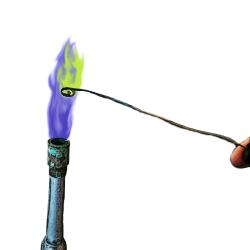Source Institutions
Source Institutions
Add to list Go to activity
Activity link broken? See if it's at the internet archive

In this chemistry lab activity, learners model the colors of fireworks by burning metallic solutions in a flame and observing the different colors produced. The color is determined by the combustion of a metallic compound, and different solutions produce different colors. Flame tests can also be used to determine the composition of materials. This activity is currently used in the Industrial Chemistry Unit in OMSI's Chemistry Lab but can done in any chemistry lab. Cost estimate does not include lab equipment. For safety reasons, this activity should be conducted as a demonstration for younger audiences.
- 30 to 45 minutes
- Under 5 minutes
- $5 - $10 per group of students
- Ages 14 - adult
- Activity, Demonstration, Experiment/Lab Activity
- English
Quick Guide
Materials List (per group of students)
- 10g lithum chloride (LiCl)
- 25g strontium chloride hexahydrate (SrCl2•6H2O)
- 25g potassium chloride dihydrate (KCl•2H2O)
- 25g barium chloride dihydrate (BaCl2•2H2O)
- 50g sodium chloride (NaCl) table salt
- 25g copper chloride dihydrate(CuCl2•2H2O)
- (optional) for mystery solution, use 6 of following three items instead of 5
- (5) small glass dropper bottles with screw caps
- (5) one-hole stoppers
- (5) test tubes
- tray for dropper bottles
- nichrome wire
- wire cutters
- pliers
- test tube rack
- 100mL glass beaker
- black paper
- bunsen burner attached by rubber tubing to gas source
- protective Plexiglas shield
- vertical Plexiglas display stand (8.5in wide and 11in high)
- handheld spark generator
Subjects
-
Physical Sciences
- Chemistry
-
Vibration and Waves
- Light and Optics
-
Light and Optics
- Sunlight and Color
-
Structure and Properties of Matter
- Atomic Structure
Audience
To use this activity, learners need to:
- see
- see color
- read
- touch
Learning styles supported:
- Involves hands-on or lab activities
Other
Access Rights:
- Free access
By:
Rights:
- All rights reserved, Oregon Museum of Science and Industry, 1997
Funding Source:
- National Science Foundation, 9355628
